An Economical Route Planning Method for Plug-In Hybrid Electric Vehicle in Real World
Abstract
:1. Introduction
1.1. Literature Review
1.1.1. Technologies Related to the Vehicle Itself
1.1.2. Vehicle-Environment Synergy Technologies
1.2. Motivation and Contribution
1.3. Outline of the Paper
2. Comparison Test between PHEVs and Conventional Vehicles
- The difference in energy consumption and travel expense in the two routs reveals that the environment can be a critical element that affects energy consumption, which is considered as the essence of route planning to a certain degree.
- PHEVs hold great potential in fuel economy improvement. With route planning, the potential of PHEVs in travel expense and fuel economy improvement can be fully extended.
- PHEVs can be driven by two power sources. When estimating travel expense or total energy consumption, the energy output of the two power sources should be considered simultaneously. Therefore, the energy management strategy should be known beforehand to make the estimation.
- Different forms pf energy utilization in PHEVs and conventional vehicles lead to the route planning being specially designed for PHEVs.
3. Real-Time Economical Route Planning for PHEVs
3.1. PHEV Customized Traffic Data Collection
3.1.1. PHEV Powertrain Model
Vehicle Longitudinal Dynamic Model
Fuel Model
Electricity Model
3.1.2. Energy Management Strategy
3.2. TEEM Building
Step 1: Required Instantaneous Longitudinal Tractive Energy Calculation
Step 2: Energy Distribution
Step 3: ETE Acquisition
4. Capability Analysis of the Proposed Route Planning Method
4.1. Evaluation of the Simulation Model
4.2. Evaluation of TEEM
4.3. Evaluation of Route Planning
5. Conclusions
Acknowledgments
Author Contributions
Conflicts of Interest
Nomenclature
| f | rolling resistance factor | m | vehicle mass |
| G | gravity acceleration | road gradient | |
| air drag coefficient | A | vehicle frontal area | |
| v | vehicle speed | required tractive torque | |
| wheel radius | a | acceleration | |
| moment of inertia | torque generated from fuel | ||
| torque produced from electricity | engine torque | ||
| engine angular velocity | wheel angular velocity | ||
| gear ratio | final drive ratio | ||
| n | gear number | transmission efficiency of fuel | |
| motor torque | motor angular velocity | ||
| transmission efficiency of electricity | battery power | ||
| battery open circuit voltage | battery internal resistance | ||
| battery maximum capacity | fuel mass flow rate | ||
| energy density of fuel | t | discrete time | |
| time interval | energy consumed by vehicle | ||
| s | equivalent factor | fuel lower heating value | |
| required engine power | engine efficiency | ||
| required instantaneous longitudinal tractive energy | u | power split ratio | |
| optimal power split ratio | correction coefficient of rotating mass | ||
| sensitivity coefficient | lag time | ||
| x | vehicle position | unimpeded velocity | |
| jam density | density of traffic flow | ||
| q | flow of a certain route segment | average speed of vehicle on a certain route segment | |
| instantaneous speed | n | number of floating cars | |
| average headway | average acceleration of the vehicle on a certain route segment | ||
| travel time on two adjacent route segments | length of the route segment | ||
| number of traffic lights | number of neighboring route segments | ||
| number of public buildings | number of traffic lights | ||
| price unit of fuel | price unit of electricity | ||
| fuel density |
References
- Chen, S.M.; He, L.Y. Welfare loss of China’s air pollution: How to make personal vehicle transportation policy. China Econ. Rev. 2014, 31, 106–118. [Google Scholar] [CrossRef]
- Zhang, K.; Batterman, S. Air pollution and health risks due to vehicle traffic. Sci. Total Environ. 2013, 450, 307–316. [Google Scholar] [CrossRef] [PubMed]
- He, H.; Wang, Y.; Ma, Q.; Ma, J.; Chu, B.; Ji, D.; Tang, G.; Liu, C.; Zhang, H.; Hao, J. Mineral dust and NOx promote the conversion of SO2 to sulfate in heavy pollution days. Sci. Rep. 2014, 4, 4172. [Google Scholar] [CrossRef] [PubMed]
- Zhang, H.; Wang, S.; Hao, J.; Wang, X.; Wang, S.; Chai, F.; Li, M. Air pollution and control action in Beijing. J. Clean. Prod. 2016, 112, 1519–1527. [Google Scholar] [CrossRef]
- Li, Q.; Qiao, F.; Yu, L. Will Vehicle and Roadside Communications Reduce Emitted Air Pollution? Int. J. Sci. Technol. 2015, 5, 17–23. [Google Scholar]
- Agarwal, A.K.; Srivastava, D.K.; Dhar, A.; Maurya, R.K.; Shukla, P.C.; Singh, A.P. Effect of fuel injection timing and pressure on combustion, emissions and performance characteristics of a single cylinder diesel engine. Fuel 2013, 111, 374–383. [Google Scholar] [CrossRef]
- Sajjad, H.; Masjuki, H.; Varman, M.; Kalam, M.; Arbab, M.; Imtenan, S.; Rahman, S.A. Engine combustion, performance and emission characteristics of gas to liquid (GTL) fuels and its blends with diesel and bio-diesel. Renew. Sustain. Energy Rev. 2014, 30, 961–986. [Google Scholar] [CrossRef]
- Kong, S.C.; Marriott, C.D.; Reitz, R.D.; Christensen, M. Modeling and Experiments of HCCI Engine Combustion Using Detailed Chemical Kinetics with Multidimensional CFD; Technical Report; SAE Technical Paper; SAE World Congress: Detroit, MI, USA, 2001. [Google Scholar]
- Kim, H.C.; Wallington, T.J.; Sullivan, J.L.; Keoleian, G.A. Life Cycle Assessment of Vehicle Lightweighting: Novel Mathematical Methods to Estimate Use-Phase Fuel Consumption. Environ. Sci. Technol. 2015, 49, 10209–10216. [Google Scholar] [CrossRef] [PubMed]
- Bubna, P.; Wiseman, M. Impact of Light-Weight Design on Manufacturing Cost—A Review of BMW i3 and Toyota Corolla Body Components; Technical Report; SAE Technical Paper; SAE World Congress and Exhibition: Detroit, MI, USA, 2016. [Google Scholar]
- Seyfried, P.; Taiss, E.J.M.; Calijorne, A.C.; Li, F.P.; Song, Q.F. Light weighting opportunities and material choice for commercial vehicle frame structures from a design point of view. Adv. Manuf. 2015, 3, 19–26. [Google Scholar] [CrossRef]
- Chen, L.; Zhang, J.; Li, Y.; Ye, Y. Mechanism analysis and evaluation methodology of regenerative braking contribution to energy efficiency improvement of electrified vehicles. Energy Convers. Manag. 2015, 92, 469–482. [Google Scholar]
- Koetse, M.J.; Hoen, A. Preferences for alternative fuel vehicles of company car drivers. Resour. Energy Econ. 2014, 37, 279–301. [Google Scholar] [CrossRef]
- Lee, S.; Speight, J.G.; Loyalka, S.K. Handbook of Alternative Fuel Technologies; CRC Press: Boca Raton, FL, USA, 2014. [Google Scholar]
- Hu, X.; Murgovski, N.; Johannesson, L.M.; Egardt, B. Comparison of three electrochemical energy buffers applied to a hybrid bus powertrain with simultaneous optimal sizing and energy management. IEEE Trans. Intell. Transp. Syst. 2014, 15, 1193–1205. [Google Scholar] [CrossRef]
- Lv, C.; Zhang, J.; Li, Y.; Yuan, Y. Directional-stability-aware brake blending control synthesis for over-actuated electric vehicles during straight-line deceleration. Mechatronics 2016, 38, 121–131. [Google Scholar] [CrossRef]
- Sockeel, N.; Shi, J.; Shahverdi, M.; Mazzola, M. Sensitivity analysis of the battery model for model predictive control implemented into a plug-in hybrid electric vehicle. In Proceedings of the 2017 IEEE Transportation Electrification Conference and Expo, Chicago, IL, USA, 22–24 June 2017; pp. 493–500. [Google Scholar]
- Zhang, J.; Lv, C.; Gou, J.; Kong, D. Cooperative control of regenerative braking and hydraulic braking of an electrified passenger car. Proc. Inst. Mech. Eng. Part D J. Automob. Eng. 2012, 226, 1289–1302. [Google Scholar] [CrossRef]
- Heutel, G.; Muehlegger, E. Consumer learning and hybrid vehicle adoption. Environ. Resour. Econ. 2015, 62, 125–161. [Google Scholar] [CrossRef]
- Rumer, R.; Witter, S.; Yao, M.; Sasahara, K.; Komada, M. Examination System for Electric Vehicle or Hybrid Electric Vehicle. U.S. Patent 9,086,333, 21 July 2015. [Google Scholar]
- Shabbir, W.; Evangelou, S.A. Real-time control strategy to maximize hybrid electric vehicle powertrain efficiency. Appl. Energy 2014, 135, 512–522. [Google Scholar] [CrossRef]
- Škugor, B.; Deur, J.; Cipek, M.; Pavković, D. Design of a power-split hybrid electric vehicle control system utilizing a rule-based controller and an equivalent consumption minimization strategy. Proc. Inst. Mech. Eng. Part D J. Automob. Eng. 2014, 228, 631–648. [Google Scholar] [CrossRef]
- Thai-Tang, N.H.; DeFrank, W.J.; Thomas, J.D. Integrated Hybrid Vehicle Control Strategy. U.S. Patent 8,548,660, 1 October 2013. [Google Scholar]
- Zou, Y.; Hou, S.; Li, D.; Gao, W.; Hu, X.S. Optimal energy control strategy design for a hybrid electric vehicle. Discret. Dyn. Nat. Soc. 2013, 2013. [Google Scholar] [CrossRef]
- Li, Y.; Lu, X.; Kar, N.C. Rule-based control strategy with novel parameters optimization using NSGA-II for power-split PHEV operation cost minimization. IEEE Trans. Veh. Technol. 2014, 63, 3051–3061. [Google Scholar] [CrossRef]
- Sim, K.; Jeong, H.; Kim, D.R.; Lee, T.K.; Han, K.; Hwang, S.H. Control Strategy with the Slope of SOC Trajectory for Plug-in Diesel Hybrid Electric Vehicle with Dual Clutch Transmission. In Proceedings of the 25th International Electric Vehicle Symposium and Exhibition (EVS28), Koyang, Korea, 3–6 May 2015. [Google Scholar]
- Lian, J.; Liu, S.; Li, L.; Liu, X.; Zhou, Y.; Yang, F.; Yuan, L. A Mixed Logical Dynamical-Model Predictive Control (MLD-MPC) Energy Management Control Strategy for Plug-in Hybrid Electric Vehicles (PHEVs). Energies 2017, 10, 74. [Google Scholar] [CrossRef]
- Berthold, F.; Ravey, A.; Blunier, B.; Bouquain, D.; Williamson, S.; Miraoui, A. Design and development of a smart control strategy for plug-in hybrid vehicles including vehicle-to-home functionality. IEEE Trans. Transp. Electr. 2015, 1, 168–177. [Google Scholar] [CrossRef]
- Tribioli, L.; Barbieri, M.; Capata, R.; Sciubba, E.; Jannelli, E.; Bella, G. A real time energy management strategy for plug-in hybrid electric vehicles based on optimal control theory. Energy Procedia 2014, 45, 949–958. [Google Scholar] [CrossRef]
- Alam, M.; Ferreira, J.; Fonseca, J. Introduction to intelligent transportation systems. In Intelligent Transportation Systems; Springer: Berlin, Germany, 2016; pp. 1–17. [Google Scholar]
- Cobo, M.J.; Chiclana, F.; Collop, A.; de Ona, J.; Herrera-Viedma, E. A bibliometric analysis of the intelligent transportation systems research based on science mapping. IEEE Trans. Intell. Transp. Syst. 2014, 15, 901–908. [Google Scholar] [CrossRef]
- Krumm, J. Ubiquitous Computing Fundamentals; CRC Press: Boca Raton, FL, USA, 2016. [Google Scholar]
- Chung, K.Y. Recent trends on convergence and ubiquitous computing. Pers. Ubiquitous Comput. 2014, 18, 1291–1293. [Google Scholar] [CrossRef]
- Wu, X.; Zhu, X.; Wu, G.Q.; Ding, W. Data mining with big data. IEEE Trans. Knowl. Data Eng. 2014, 26, 97–107. [Google Scholar]
- Rokach, L.; Maimon, O. Data Mining with Decision Trees: Theory and Applications; World Scientific: Singapore, 2014. [Google Scholar]
- Kong, F.; Liu, X.; Sun, Z.; Wang, Q. Smart Rate Control and Demand Balancing for Electric Vehicle Charging. In Proceedings of the 2016 ACM/IEEE 7th International Conference on Cyber-Physical Systems, Vienna, Austria, 11–14 April 2016; p. 4. [Google Scholar]
- Wang, Q.; Liu, X.; Du, J.; Kong, F. Smart Charging for Electric Vehicles: A Survey From the Algorithmic Perspective. IEEE Commun. Surv. Tutor. 2016, 18, 1500–1517. [Google Scholar] [CrossRef]
- Lv, C.; Liu, Y.; Hu, X.; Guo, H.; Cao, D.; Wang, F.Y. Simultaneous Observation of Hybrid States for Cyber-Physical Systems: A Case Study of Electric Vehicle Powertrain. IEEE Trans. Cybern. 2017. [Google Scholar] [CrossRef] [PubMed]
- Bast, H.; Delling, D.; Goldberg, A.; Müller-Hannemann, M.; Pajor, T.; Sanders, P.; Wagner, D.; Werneck, R.F. Route planning in transportation networks. In Algorithm Engineering; Springer: Berlin, Germany, 2016; pp. 19–80. [Google Scholar]
- Letchner, J.M.; Krumm, J.C.; Horvitz, E.J. Collaborative Route Planning for Generating Personalized and Context-Sensitive Routing Recommendations. U.S. Patent 8,718,925, 6 May 2014. [Google Scholar]
- Perez, J. Route Planning Using Parking Reservations. U.S. Patent App. 14/639,216, 9 October 2015. [Google Scholar]
- Dibbelt, J.; Pajor, T.; Wagner, D. User-constrained multimodal route planning. J. Exp. Algorithmics JEA 2015, 19, 3.2. [Google Scholar] [CrossRef]
- Yang, B.; Guo, C.; Jensen, C.S.; Kaul, M.; Shang, S. Stochastic skyline route planning under time-varying uncertainty. In Proceedings of the 2014 IEEE 30th International Conference on Data Engineering, Chicago, IL, USA, 31 March–4 April 2014; pp. 136–147. [Google Scholar]
- Kang, Y.; Batta, R.; Kwon, C. Generalized route planning model for hazardous material transportation with var and equity considerations. Comput. Oper. Res. 2014, 43, 237–247. [Google Scholar] [CrossRef]
- Marino, M.; Gardi, A.; Ramasamy, M.S.; Kistan, M.T.; Sabatini, R.; Olynn, M.; Bernard-Flattot, P. System Level Implementation, Verification Requirements and Simulation Case Studies for 4D Route Planning and Dynamic Airspace Functionalities; Technical Report; RMIT University: Melbourne, Australia, 2015. [Google Scholar]
- Minor, E.S.; Urban, D.L. A graph-theory framework for evaluating landscape connectivity and conservation planning. Conserv. Biol. 2008, 22, 297–307. [Google Scholar] [CrossRef] [PubMed]
- Chen, C.; Zhang, D.; Zhou, Z.H.; Li, N.; Atmaca, T.; Li, S. B-Planner: Night bus route planning using large-scale taxi GPS traces. In Proceedings of the IEEE International Conference on Pervasive Computing and Communications, San Diego, CA, USA, 18–22 March 2013; pp. 225–233. [Google Scholar]
- Ghaem, S.; Kirson, A.M.; Doi, R.M. Vehicle Route Planning System. U.S. Patent 5,172,321, 15 December 1992. [Google Scholar]
- Wiener, J.M.; Mallot, H.A. ‘Fine-to-coarse’ route planning and navigation in regionalized environments. Spat. Cogn. Comput. 2003, 3, 331–358. [Google Scholar] [CrossRef]
- Delling, D.; Goldberg, A.V.; Pajor, T.; Werneck, R.F. Customizable route planning. In Proceedings of the International Symposium on Experimental Algorithms, Crete, Greece, 5–7 May 2011; Springer: Berlin, Germany, 2011; pp. 376–387. [Google Scholar]
- Toth, P.; Vigo, D. Vehicle Routing: Problems, Methods, and Applications; SIAM: Philadelphia, PA, USA, 2014. [Google Scholar]
- Kim, B.W.; Kim, J.W. Method and Apparatus for Collecting Traffic Data in Real Time. U.S. Patent App. 10/637,877, 9 December 2004. [Google Scholar]
- Bagué, A.V. Traffic Accident Data Recorder and Traffic Accident Reproduction System and Method. U.S. Patent 6,246,933, 12 June 2001. [Google Scholar]
- Kerner, B.; Demir, C.; Herrtwich, R.; Klenov, S.; Rehborn, H.; Aleksic, M.; Haug, A. Traffic state detection with floating car data in road networks. In Proceedings of the 2005 IEEE Intelligent Transportation Systems, Vienna, Austria, 13–16 September 2005; pp. 44–49. [Google Scholar]
- Zheng, Y.; Capra, L.; Wolfson, O.; Yang, H. Urban computing: Concepts, methodologies, and applications. ACM Trans. Intell. Syst. Technol. TIST 2014, 5, 38. [Google Scholar] [CrossRef]
- Khavakh, A.; McDonough, W.; Voloshin, O.; Wang, Y. Method and System for Route Calculation in a Navigation Application. U.S. Patent 6,192,314, 20 February 2001. [Google Scholar]
- Chen, J.C. Dijkstra’s shortest path algorithm. J. Formaliz. Math. 2003, 15, 237–247. [Google Scholar]
- Goldberg, A.V.; Kaplan, H.; Werneck, R.F. Reach for A*: Efficient point-to-point shortest path algorithms. In Proceedings of the Eighth Workshop on Algorithm Engineering and Experiments (ALENEX), Miami, FL, USA, 21 January 2006; SIAM: Philadelphia, PA, USA, 2006; pp. 129–143. [Google Scholar]
- Kumar, V.; Schwabe, E.J. Improved algorithms and data structures for solving graph problems in external memory. In Proceedings of the Eighth IEEE Symposium on Parallel and Distributed Processing, New Orleans, LA, USA, 23–26 October 1996; pp. 169–176. [Google Scholar]
- Bu, F.; Fang, H. Shortest path algorithm within dynamic restricted searching area in city emergency rescue. In Proceedings of the 2010 IEEE International Conference on Emergency Management and Management Sciences, Beijing, China, 8–10 August 2010; pp. 371–374. [Google Scholar]
- El-Zonkoly, A. Intelligent energy management of optimally located renewable energy systems incorporating PHEV. Energy Convers. Manag. 2014, 84, 427–435. [Google Scholar] [CrossRef]
- Peng, J.; He, H.; Xiong, R. Rule based energy management strategy for a series–parallel plug-in hybrid electric bus optimized by dynamic programming. Appl. Energy 2017, 185, 1633–1643. [Google Scholar] [CrossRef]
- Jin, Y.; Xie, Z.; Chen, J.; Chen, E. Phev power distribution fuzzy logic control strategy based on prediction. J. Zhejiang Univ. Technol. 2015, 43, 97–102. [Google Scholar]
- Sivertsson, M.; Eriksson, L. Design and evaluation of energy management using map-based ECMS for the PHEV benchmark. Oil Gas Sci. Technol. Revue d’IFP Energies Nouv. 2015, 70, 195–211. [Google Scholar] [CrossRef]
- Yu, H.; Kuang, M.; McGee, R. Trip-oriented energy management control strategy for plug-in hybrid electric vehicles. IEEE Trans. Control Syst. Technol. 2014, 22, 1323–1336. [Google Scholar]
- Khayyam, H.; Bab-Hadiashar, A. Adaptive intelligent energy management system of plug-in hybrid electric vehicle. Energy 2014, 69, 319–335. [Google Scholar] [CrossRef]
- Song, Z.; Hofmann, H.; Li, J.; Han, X.; Ouyang, M. Optimization for a hybrid energy storage system in electric vehicles using dynamic programing approach. Appl. Energy 2015, 139, 151–162. [Google Scholar] [CrossRef]
- Chen, Z.; Mi, C.C.; Xu, J.; Gong, X.; You, C. Energy management for a power-split plug-in hybrid electric vehicle based on dynamic programming and neural networks. IEEE Trans. Veh. Technol. 2014, 63, 1567–1580. [Google Scholar] [CrossRef]
- O’Keefe, M.P.; Markel, T. Dynamic Programming Applied to Investigate Energy Management Strategies for a Plug-In HEV; Technical Report; National Renewable Energy Laboratory (NREL): Golden, CO, USA, 2006. [Google Scholar]
- Laporte, R. Hybrid Electric PowertrainComparative Study. Master’s Thesis, KTH Royal Institute of Technology, Stockholm, Sweden, 2012. [Google Scholar]
- Patil, R.M.; Filipi, Z.; Fathy, H.K. Comparison of supervisory control strategies for series plug-in hybrid electric vehicle powertrains through dynamic programming. IEEE Trans. Control Syst. Technol. 2014, 22, 502–509. [Google Scholar] [CrossRef]
- Daniel, L.; Loree, P.; Whitener, A. Inside MapInfo Professional: The Friendly User Guide to MapInfo Professional; Cengage Learning: Boston, MA, USA, 2002. [Google Scholar]
- Ding, Y.; Chen, C.; Zhang, S.; Guo, B.; Yu, Z.; Wang, Y. GreenPlanner: Planning personalized fuel-efficient driving routes using multi-sourced urban data. In Proceedings of the 2017 IEEE International Conference on Pervasive Computing and Communications, Kona, HI, USA, 13–17 March 2017; pp. 207–216. [Google Scholar]
- Zhang, Y.; Chu, L.; Fu, Z.; Xu, N.; Guo, C.; Zhang, X.; Chen, Z.; Wang, P. Optimal energy management strategy for parallel plug-in hybrid electric vehicle based on driving behavior analysis and real time traffic information prediction. Mechatronics 2017, 46, 177–192. [Google Scholar] [CrossRef]
- Bao, M.S.H.G.L. A general microscopic simulation system of urban traffic flow. J. Syst. Eng. 1998, 4, 8–15. [Google Scholar]
- Edie, L.C. Car-following and steady-state theory for noncongested traffic. Oper. Res. 1961, 9, 66–76. [Google Scholar] [CrossRef]
- Wan, E.A.; Van Der Merwe, R. The unscented Kalman filter for nonlinear estimation. In Proceedings of the IEEE 2000 Adaptive Systems for Signal Processing, Communications, and Control Symposium, Lake Louise, AB, Canada, 4 October 2000; pp. 153–158. [Google Scholar]
- Haklay, M.; Weber, P. Openstreetmap: User-generated street maps. IEEE Pervasive Comput. 2008, 7, 12–18. [Google Scholar] [CrossRef]
- Montgomery, D.C.; Peck, E.A.; Vining, G.G. Introduction to Linear Regression Analysis; John Wiley & Sons: New York, NY, USA, 2015. [Google Scholar]
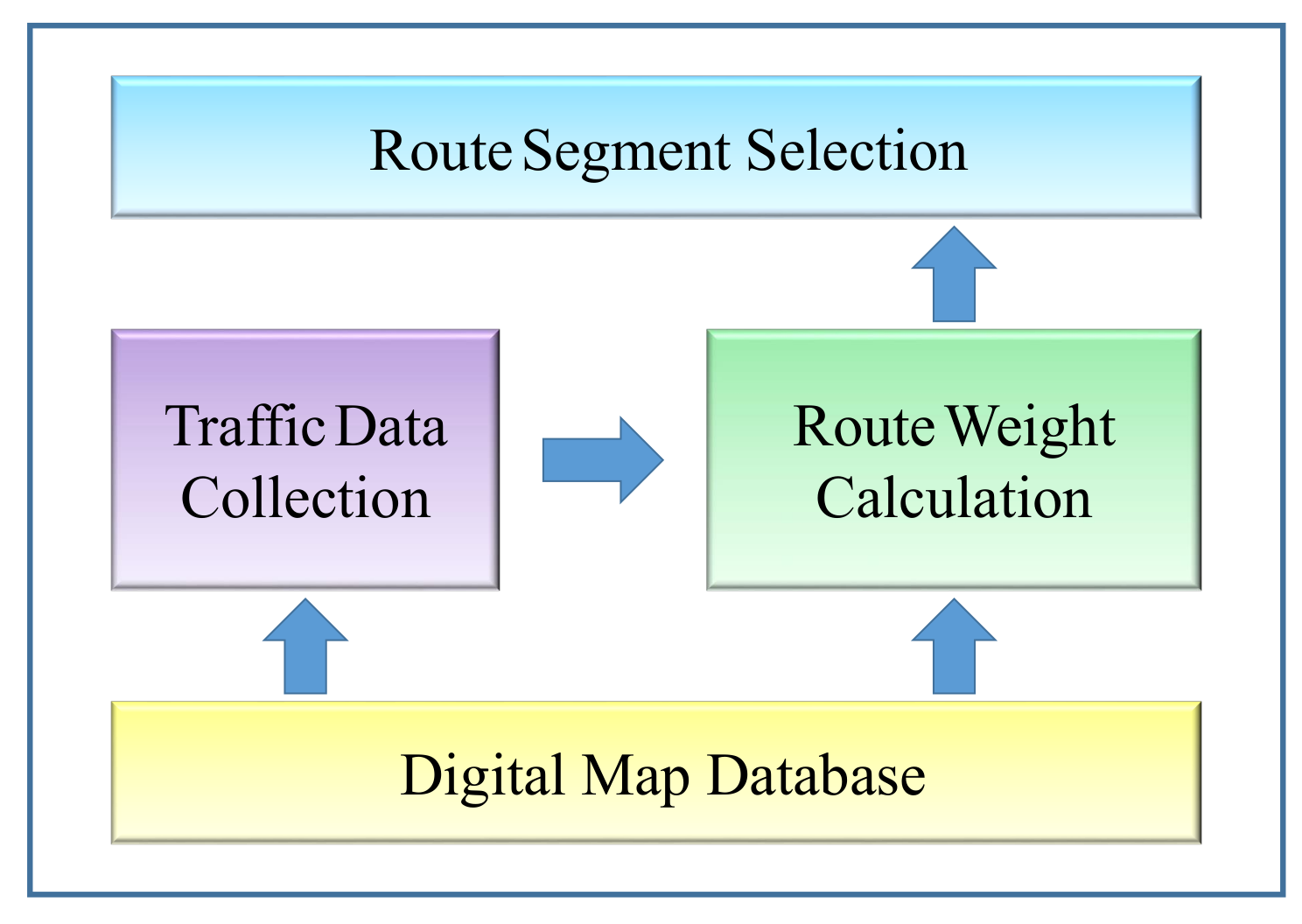
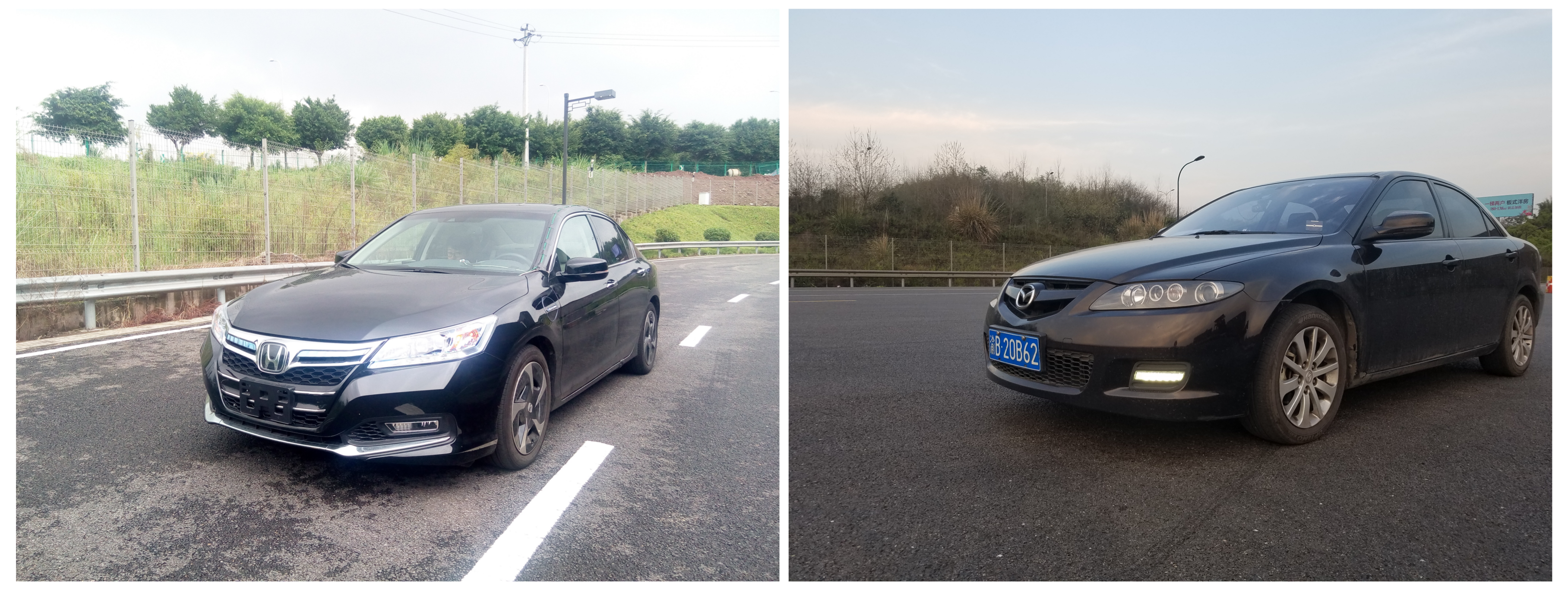
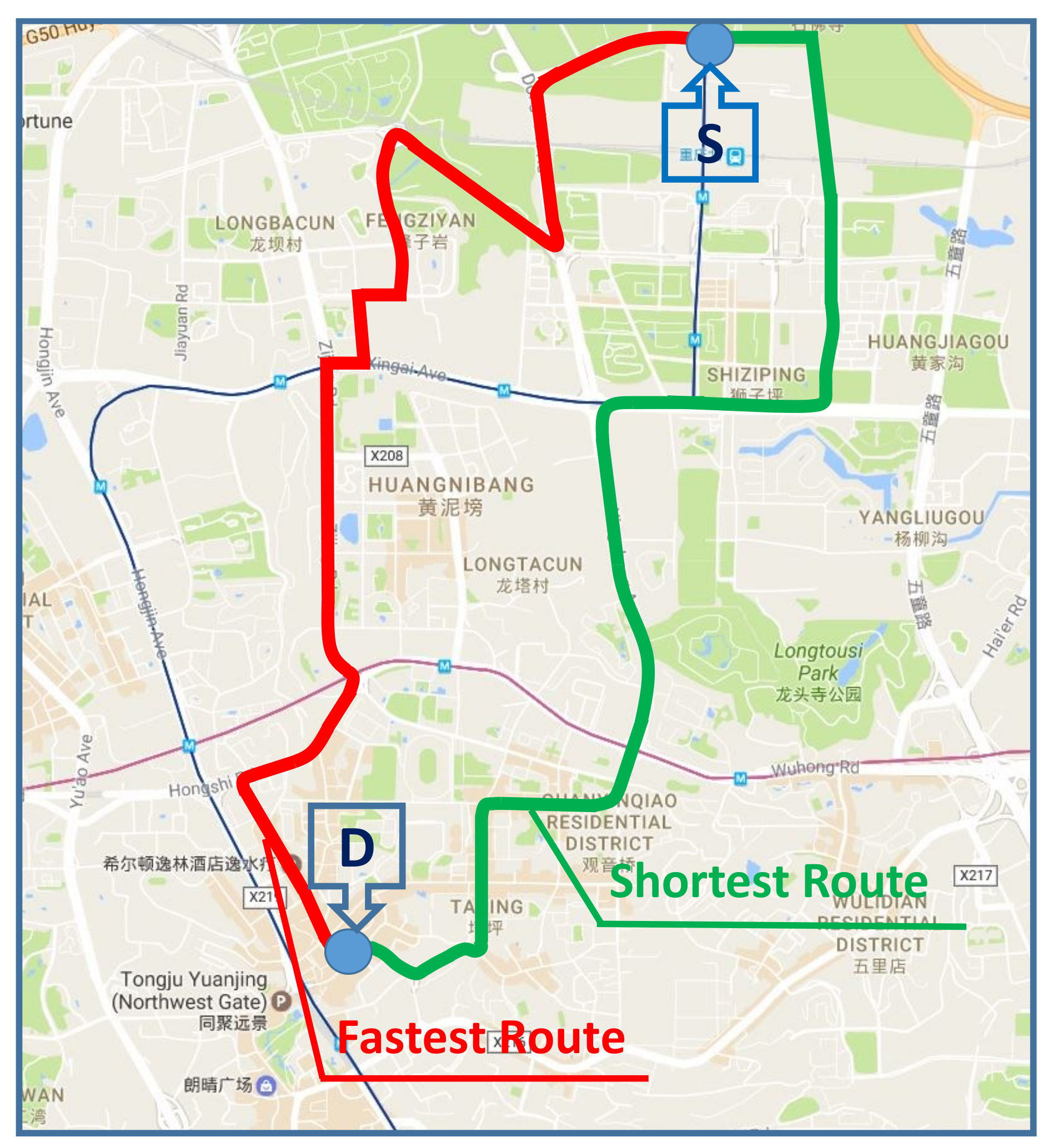
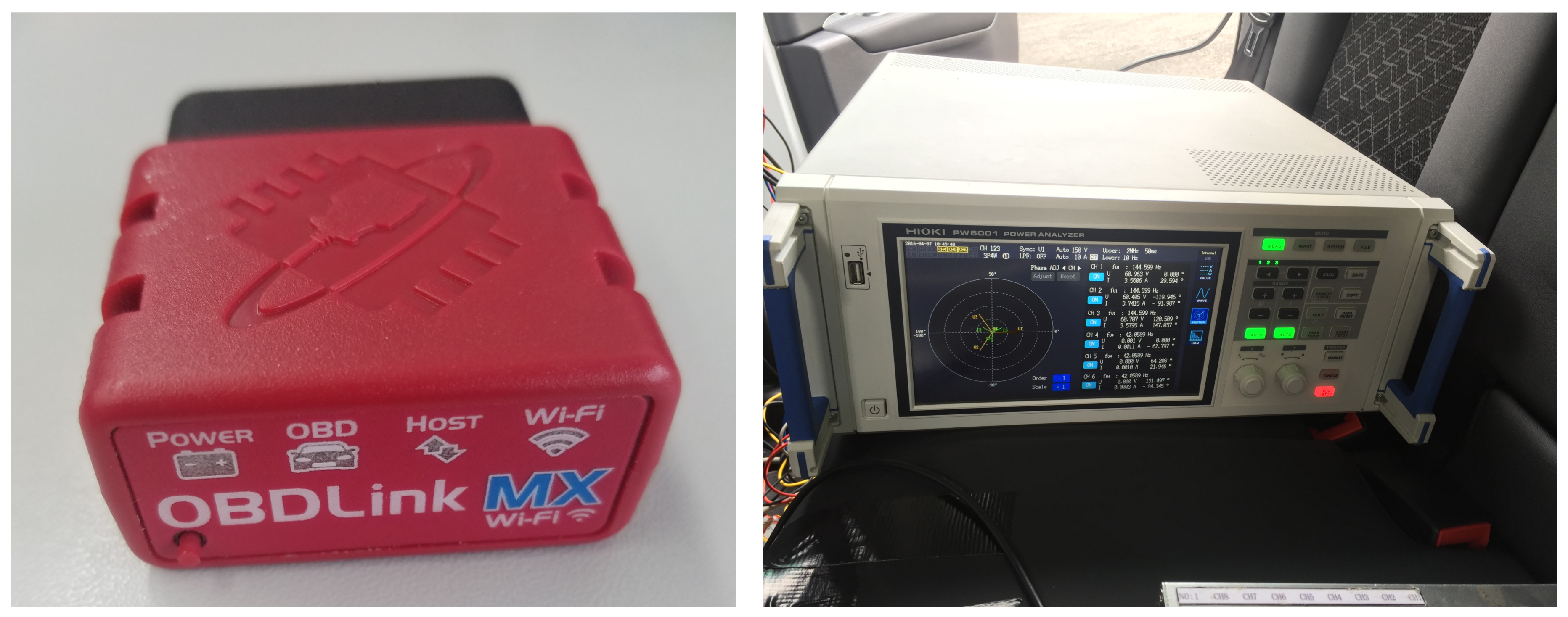
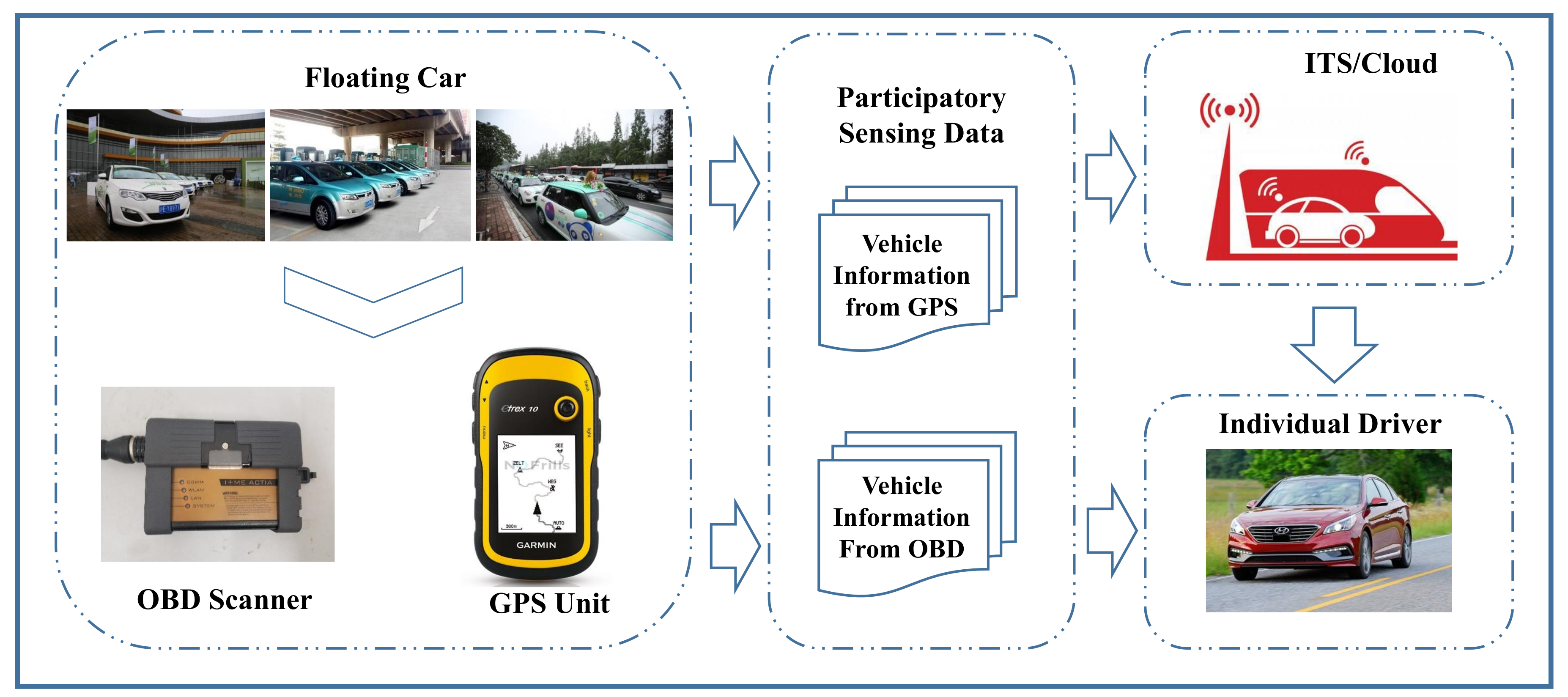
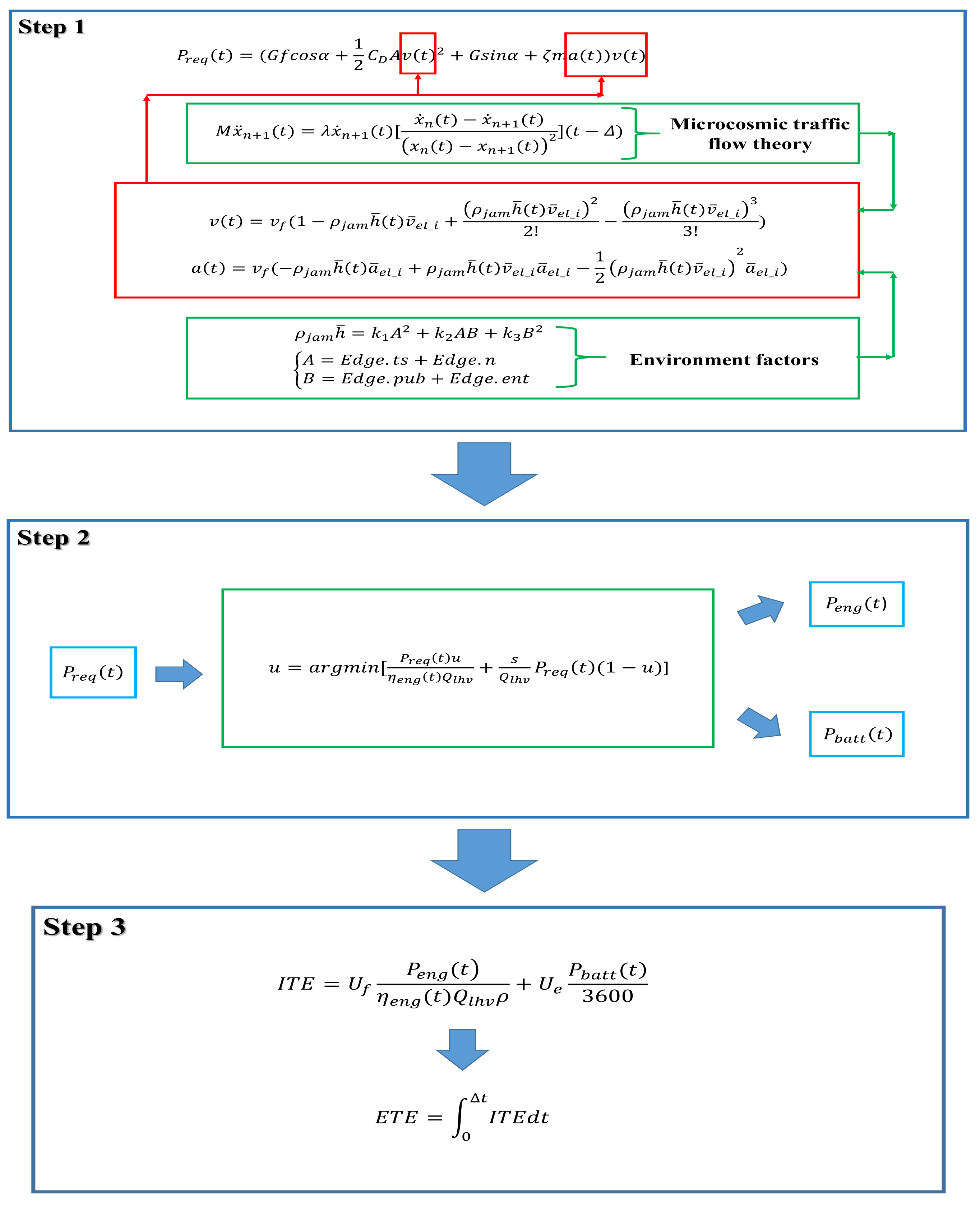
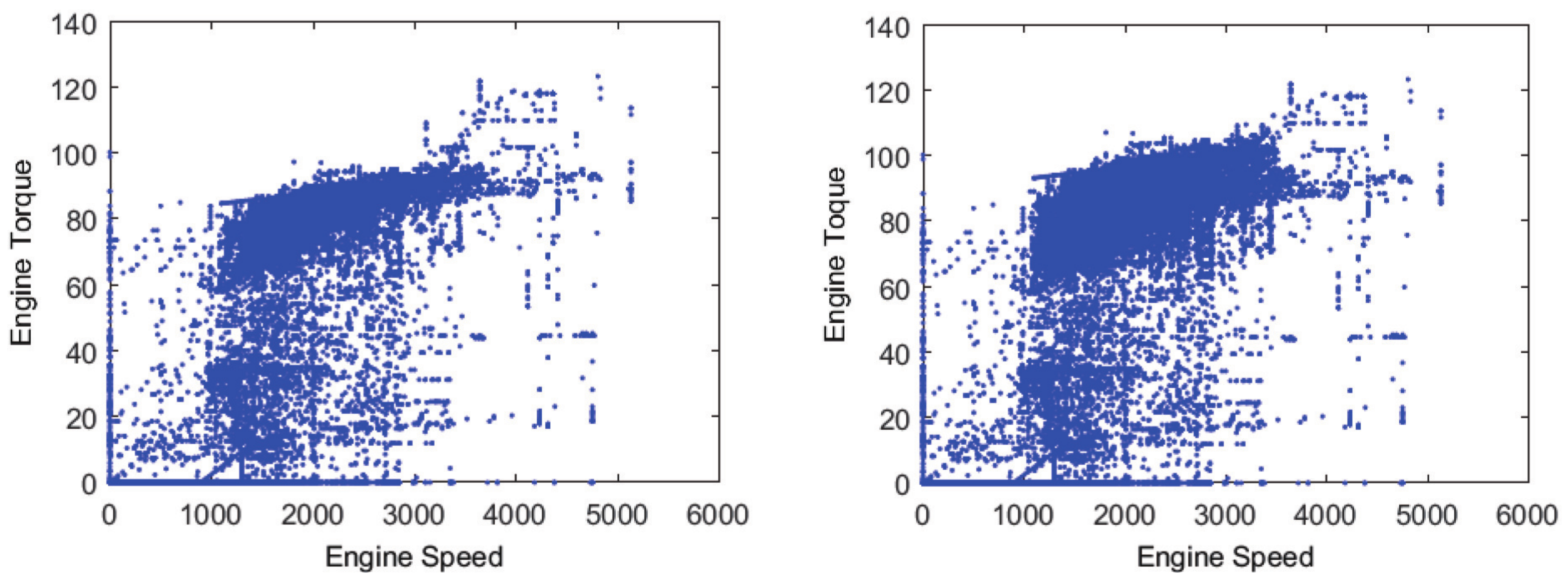
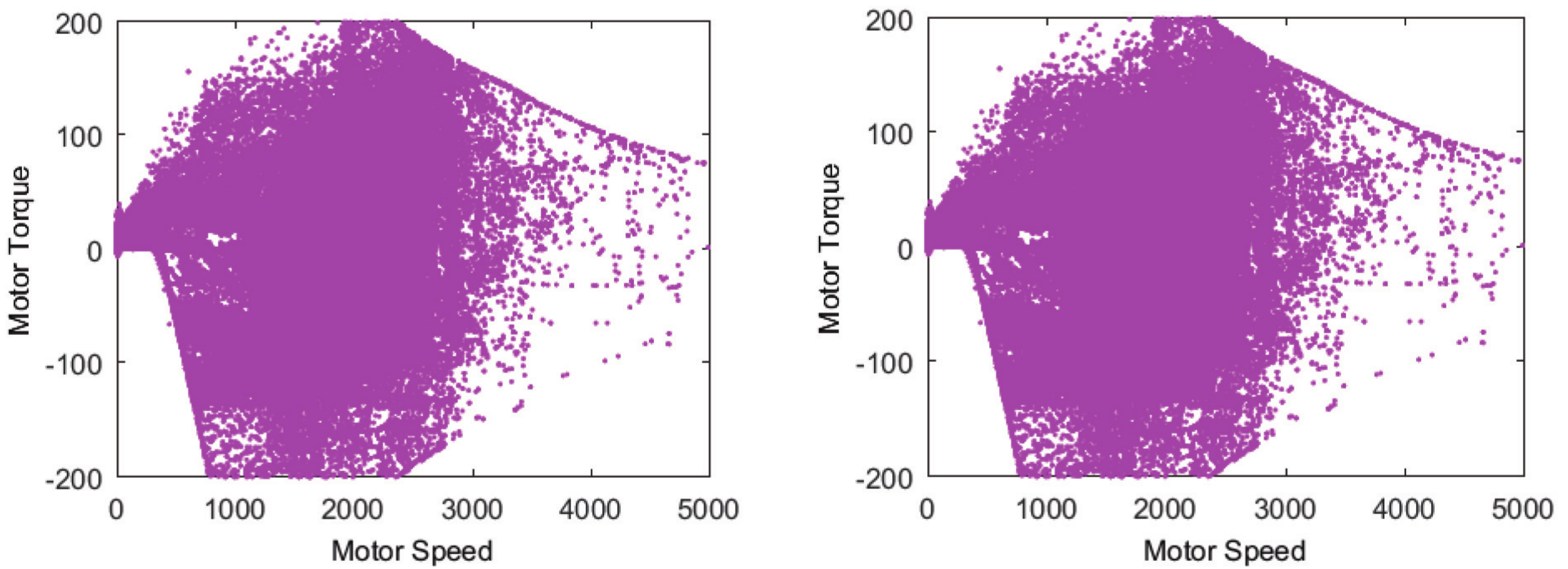
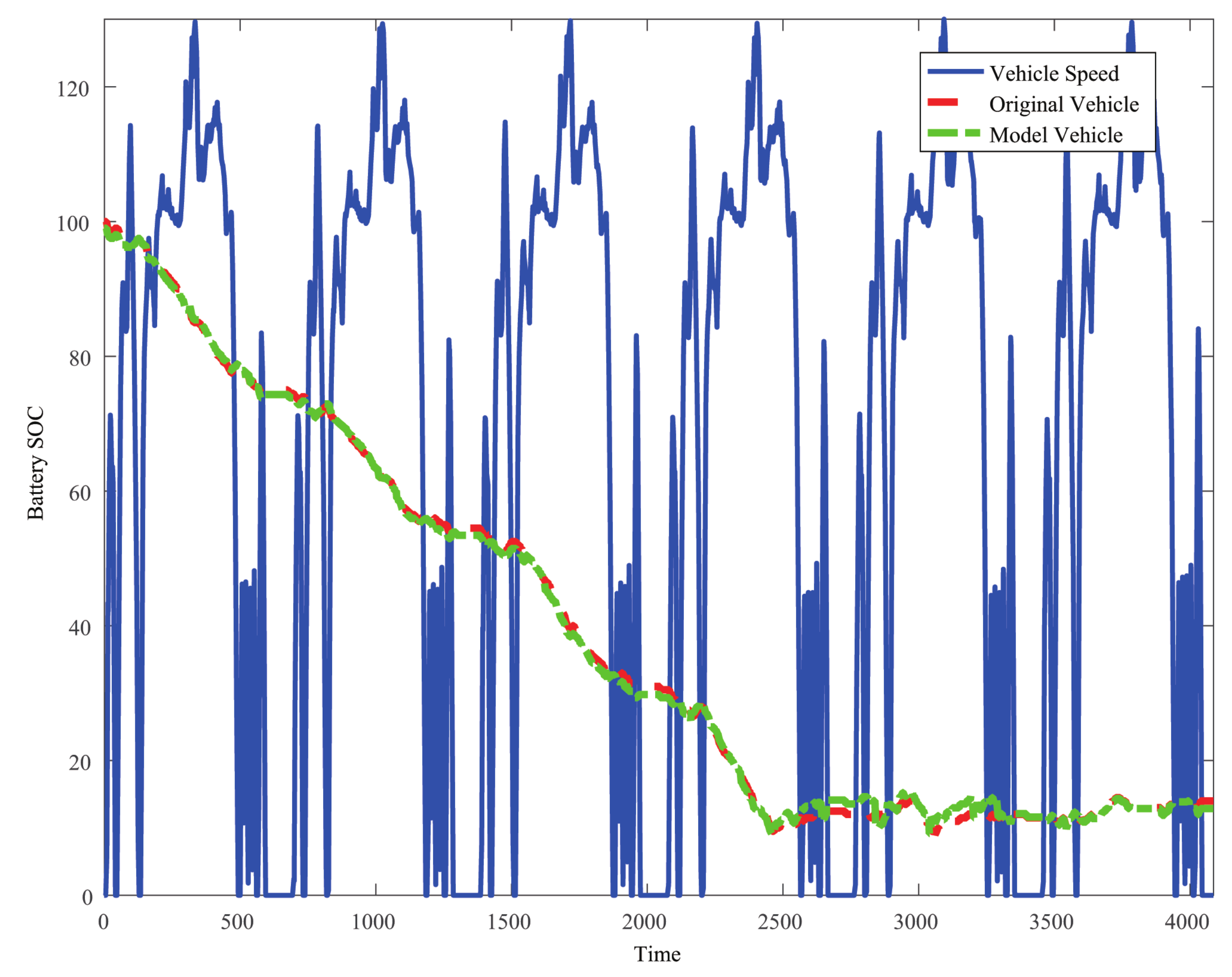
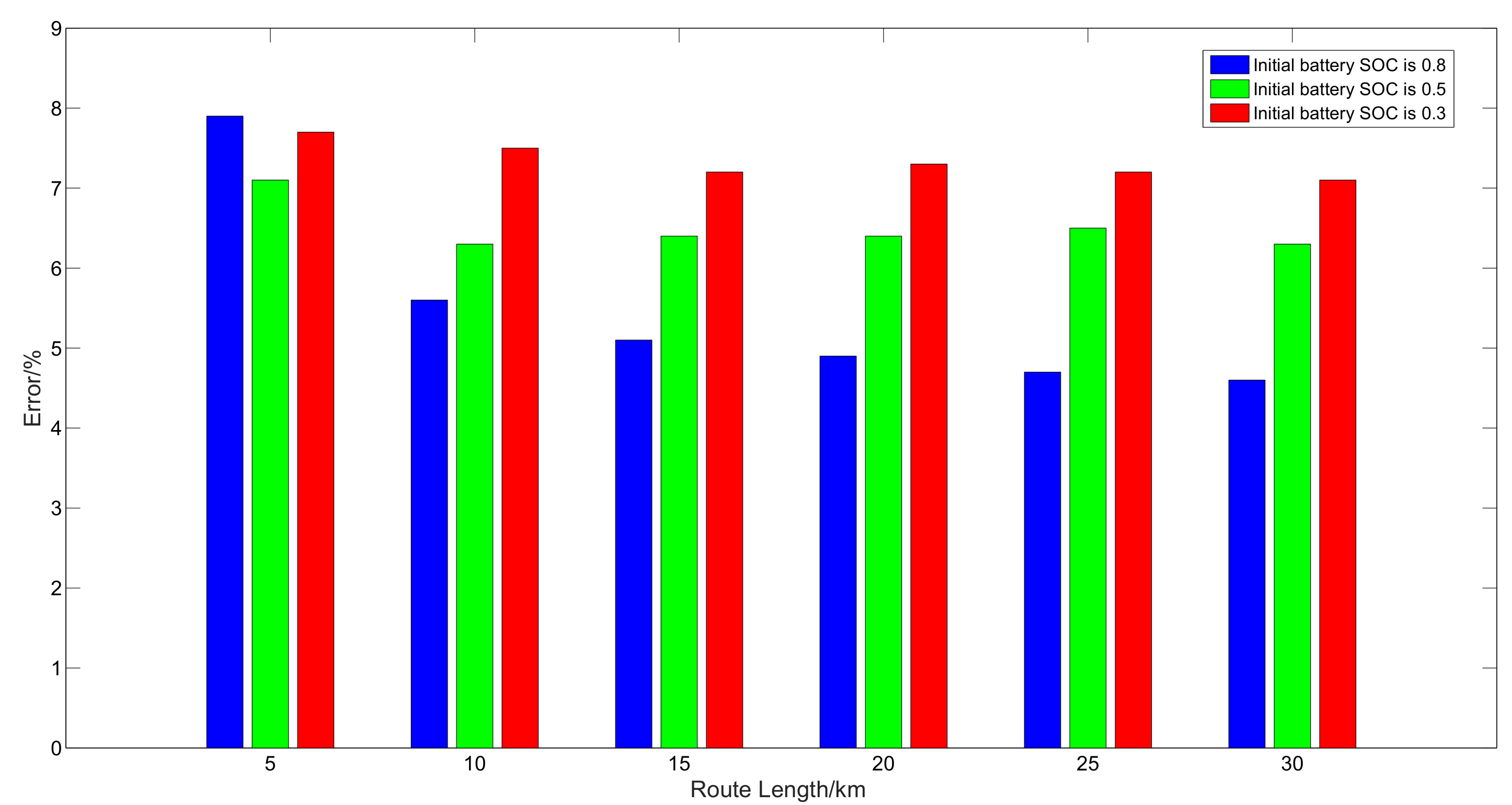
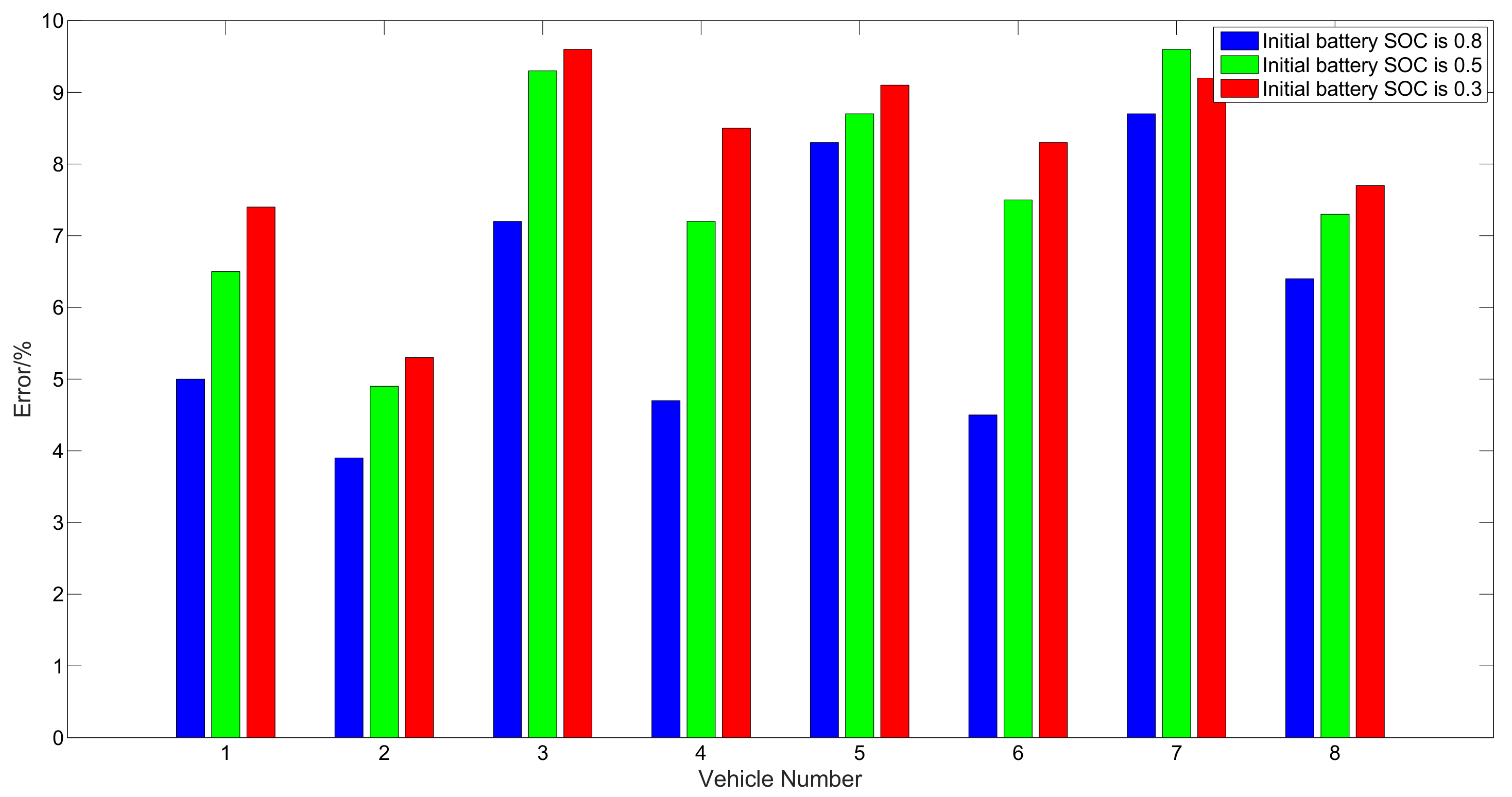
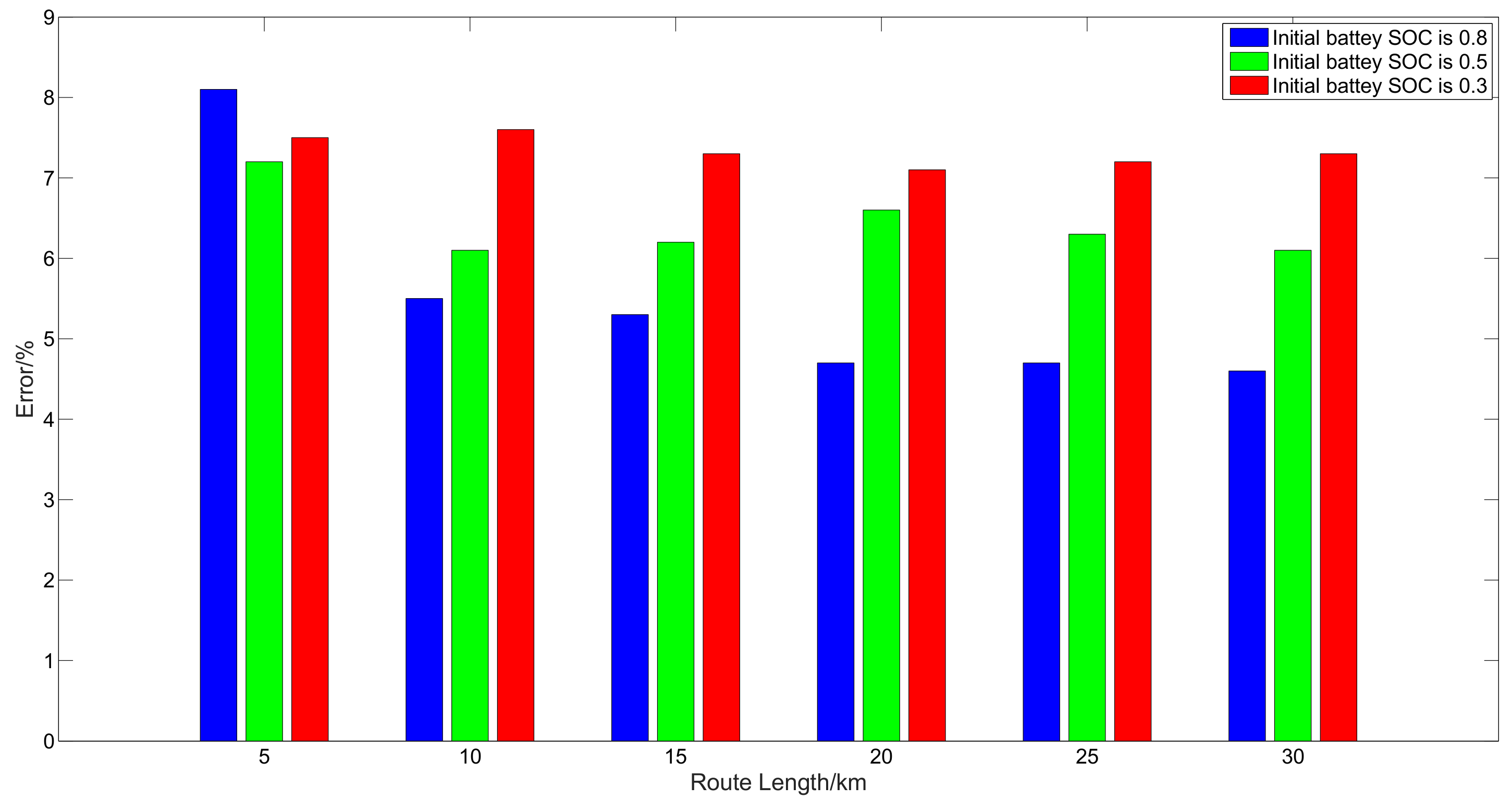
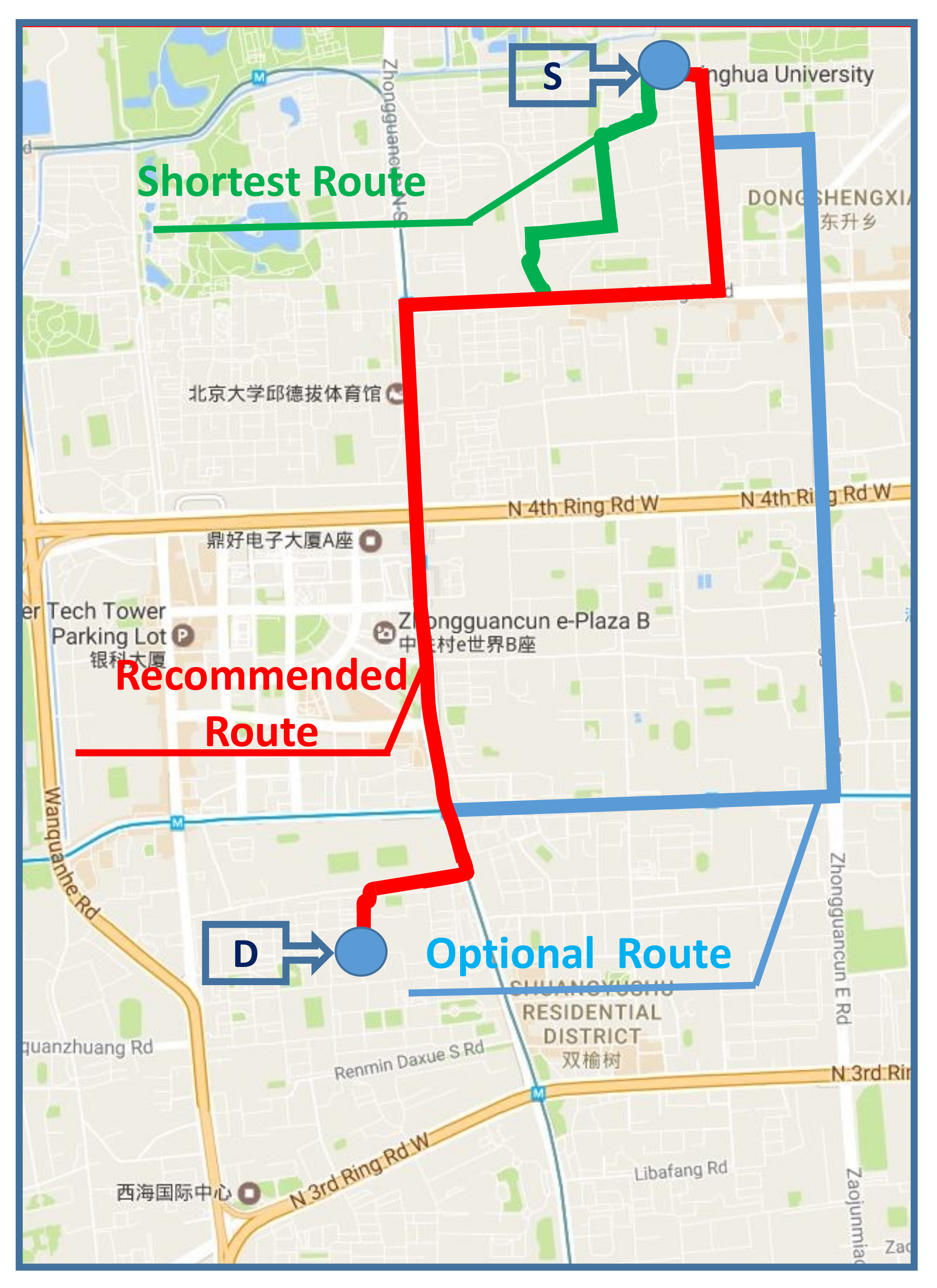

| Initial Battery SOC | Route | Fuel Consumption/L | Electricity Consumption/kWh | Travel Expense/Yuan |
|---|---|---|---|---|
| 0.3 | Fastest Route (8.9 km) | 0.32 | 0.20 | 2.44 |
| Shortest Route (7.7 km) | 0.37 | 0.13 | 2.64 | |
| 0.8 | Fastest Route (8.9 km) | 0 | 0.76 | 1.36 |
| Shortest Route (7.7 km) | 0 | 0.67 | 1.20 |
| Route | Fuel Consumption/L | Travel Expense/Yuan |
|---|---|---|
| Fastest Route (8.9 km) | 0.7697 | 5.03 |
| Shortest Route (7.7 km) | 0.6514 | 4.26 |
| No. | Vehicle Brand | Vehicle Model |
|---|---|---|
| 1 | Hyundai | Sonata |
| 2 | Audi | A3 e-tron |
| 3 | Benz | C350el |
| 4 | Kia | Optimal |
| 5 | FAW | Hongqi H7 |
| 6 | VW | Golf GTE |
| 7 | Volvo | S60 L |
| 8 | FAW | Benteng B50 |
| Vehicle Velocity Difference (m/s) | The Percentage of the Total Number |
|---|---|
| ≤1 | 93.5% |
| ≤2 | 98.1% |
| ≤3 | 99.3% |
| ≤4 | 99.9% |
| Routes | Recommended (Fastest) Route (4.8 km) | Shortest Route (4.5 km) | Optional Route (5.4 km) | |
|---|---|---|---|---|
| Items | ||||
| Fuel Consumption/L | 0.18 | 0.22 | 0.26 | |
| Electricity Consumption/kWh | 0.15 | 0.08 | 0.12 | |
| Travel Expense/Yuan | 1.43 | 1.57 | 1.91 | |
| Routes | Fastest Route (4.8 km) | Recommended (Shortest) Route (4.5 km) | Optional Route (5.4 km) | |
|---|---|---|---|---|
| Items | ||||
| Fuel Consumption/L | 0 | 0 | 0 | |
| Electricity Consumption/kWh | 0.41 | 0.39 | 0.48 | |
| Travel Expense/Yuan | 0.74 | 0.69 | 0.86 | |
© 2017 by the authors. Licensee MDPI, Basel, Switzerland. This article is an open access article distributed under the terms and conditions of the Creative Commons Attribution (CC BY) license (http://creativecommons.org/licenses/by/4.0/).
Share and Cite
Zhang, Y.; Chu, L.; Fu, Z.; Xu, N.; Guo, C.; Li, Y.; Chen, Z.; Sun, H.; Bai, Q.; Ou, Y. An Economical Route Planning Method for Plug-In Hybrid Electric Vehicle in Real World. Energies 2017, 10, 1775. https://doi.org/10.3390/en10111775
Zhang Y, Chu L, Fu Z, Xu N, Guo C, Li Y, Chen Z, Sun H, Bai Q, Ou Y. An Economical Route Planning Method for Plug-In Hybrid Electric Vehicle in Real World. Energies. 2017; 10(11):1775. https://doi.org/10.3390/en10111775
Chicago/Turabian StyleZhang, Yuanjian, Liang Chu, Zicheng Fu, Nan Xu, Chong Guo, Yukuan Li, Zhouhuan Chen, Hanwen Sun, Qin Bai, and Yang Ou. 2017. "An Economical Route Planning Method for Plug-In Hybrid Electric Vehicle in Real World" Energies 10, no. 11: 1775. https://doi.org/10.3390/en10111775





